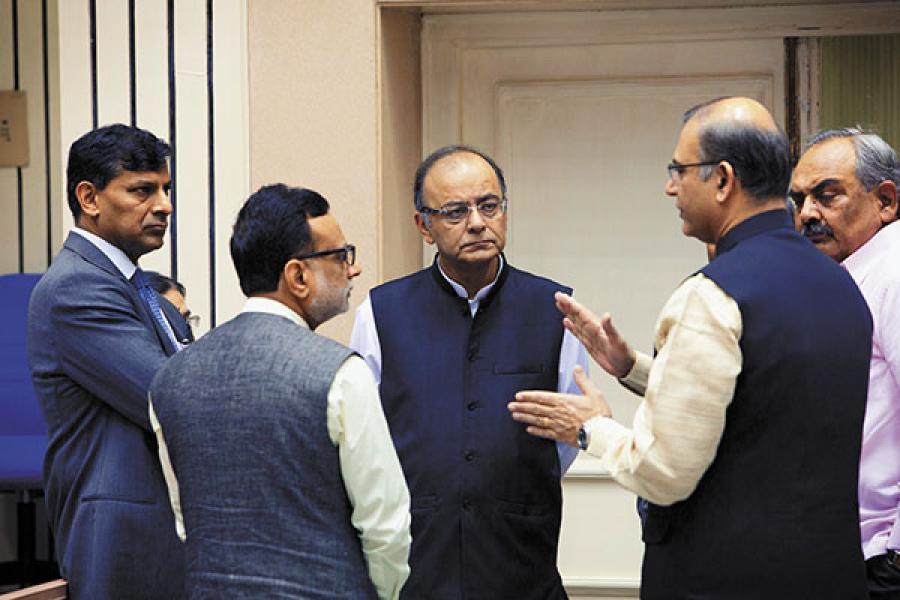
The seeds of structural changes will bear fruit: Ashok Wadhwa
The Modi-led government has opted to administer three structural resets which, by definition, may entail short-term pain for long-term gain, and 2016 is likely to ring in the latter
The year 2015 marked the beginning of the National Democratic Alliance (NDA) government’s second innings in all earnest following a seven-month settling-in period.
After a decade-long lull on the reform front, the NDA government ushered in a period marked by a series of small but meaningful reforms. The launch of a seven-pronged plan to revamp public sector banks (PSBs) called ‘Indradhanush’, allowance of foreign direct investment (FDI) in a range of new sectors (such as defence, construction and railways), the launch of a scheme to revive discoms called Ujwal Discom Assurance Yojana (UDAY), a revival in Coal India’s performance, the enactment of the Black Money (Undisclosed Foreign Income and Assets) and Imposition of Tax Act and the acceptance of the 14th Finance Commission’s recommendations (which dramatically increased the states’ share in central taxes) were some of the key reforms that the NDA government administered.
Despite this, the broader economy’s health remained fragile. This was largely because the Narendra Modi-led government opted to administer ‘three structural resets’ which, by definition, were likely to entail short-term pain but long-term gain. These structural resets were centred on: (1) Shifting India’s savings landscape away from gold and land and towards the formal financial system by curbing the size of the black economy, (2) disrupting the Indian crony capitalism model, and (3) redefining India’s subsidy mechanism.
For instance, the finance minister’s budget speech for FY16 clearly indicated the government’s intention to compress India’s black economy through potential legislative changes, including a law dealing with black money stashed abroad. This explicit compression of the black economy has meant the persistence of subdued land and real estate prices. However, from a medium-term perspective, the lower demand for physical assets (as opposed to financial assets) is likely to play a critical role in reducing the cost of land and debt capital in India.
As regards the second reset, India’s core model of corruption had shifted to a different level in the ’90s, as various political-business cliques captured large sectors of the economy and then suppressed competition in the sector in a bid to maximise their gains. The Modi-led administration has consistently and systematically focussed on cleansing the Indian government machinery of corruption by introducing e-platforms and by cracking down on corrupt practices prevailing in a range of pivotal ministries. Whilst this process of purging is positive from a long- to medium-term perspective, this has meant that several capitalists of India are refusing to begin capex activity in the short term, as they see reduced scope for supernormal profits in this new environment.
The third reset is centred on redefining subsidies in India by curbing the overall quantum of subsidies as well as improving the targeting of subsidies. For instance, India’s subsidy bill expanded at a compound annual growth rate (CAGR) of 19 percent per annum between FY04 and FY14. However, as is already evident from the last two budgets that this government has prepared, this dispensation is keen on curbing the size of the subsidy bill where the subsidy bill has contracted by a CAGR of 2 percent per annum. Further, the Modi-led government remains committed to better targeting of subsides in India by creating and then using the direct benefit transfer (DBT) platform. Given that there exists a strong positive relationship between the pace of growth of subsidies and wage inflation, as the government reduces spending on subsidies, wage inflation in rural India will come down, bringing down the cost of labour. However, in the short term, these alterations in the subsidy regime will adversely affect rural/semi-urban consumption and construction activity.
The current government’s decision to sacrifice short-term GDP growth for the sake of creating an economy characterised by a smaller black economy, fewer crony capitalists and a minimal subsidy bill has been responsible for the real economy coming under temporary stress.
However, I am extremely optimistic about 2016 and the potential this year holds for the investment industry for two reasons: One, the adverse impact of PM Modi’s ‘three resets’ will start abating in 2016 as the economy adjusts itself to the structural reform being administered by the government and two, a range of significant reforms that the government has been working on over the last 18 months are likely to see the light of the day. This is expected to include the following:
The implementation of a single unified indirect tax regime in India: The current indirect tax regime in India is a complex multi-layered system under which governments at various levels have the power to levy taxes at different points in time in the value chain. This creates a cascading impact of taxation and hinders inter-state trade. The proposed Goods and Services Tax (GST) will be a destination-based tax on consumption of goods and services with an input credit mechanism across the value chain.
The refreshingly conciliatory stance adopted by the ruling NDA government should technically allow it to be in a position to implement GST during FY17. Whilst the multi-tiered structure of GST will mean that the short-term GDP gains will be capped, India’s GST even in this diluted form will be tax revenue accretive, as it results in improving direct tax compliance and also brings the country’s large and untaxed unorganised sector under its ambit.
Updation of India’s archaic bankruptcy procedures: The government has been working on overhauling the existing bankruptcy laws, and the proposed ‘New Bankruptcy Code’ is a big step forward for Indian lenders, as it will facilitate easy and time-bound closure of businesses. The new bill has been tabled in Parliament and given the government’s keenness to enact the same, India could have its new bankruptcy code by June 2016. Once enacted, not only will it improve the ease of doing business in India, it will also ensure better debt recovery for creditors.
The evolution of the Reserve Bank of India (RBI) into a committee-driven inflation-focussed central bank: The RBI will finally transition into a committee framework for deciding policy rates in 2016, as is the practice in most developed economies. The RBI and the finance ministry have already signed a memorandum of understanding of setting CPI as the nominal anchor, and as a part of this agreement, the RBI will have to work towards bringing down the nominal anchor to 4 percent (+/-2 percent) by January 2017. The next step will be to amend the RBI Act of 1934 to provide for a committee framework, an issue which the government is keen on expediting. The combination of formal inflation targeting and the adoption of the committee framework will put India at par with the best international practices, thereby improving the global investment community’s perception regarding India.
Government’s focus on roads and railways is likely to pay off: Within the broader infrastructure space, roads and railways have emerged as the two key focus areas of this government. In the roads sector, order awards in 1HFY16 have increased 6x compared to a year ago. In railways, spending on electrification and doubling has increased by 47 percent and 44 percent year-on-year respectively in 1HFY16. This will aid decongestion of key corridors even as work on the dedicated freight corridors continues.
Likely revival of the state electricity boards (SEBs): The NDA’s UDAY scheme scores better than the UPA’s debt restructuring scheme of 2013, as UDAY puts higher accountability on states for reducing losses and curbs bank funding of SEB losses. The financial health of the SEBs which sign the UDAY scheme is likely to improve in 2016. Whilst Andhra Pradesh has already signed up for the scheme, Rajasthan, Uttar Pradesh, Tamil Nadu and Haryana are likely to sign up too.
Ease of doing business in India is set to improve: India is currently ranked 130th out of the total 189 countries in the World Bank’s Ease of Doing Business rankings for 2015. Reforms such as addressing infrastructure bottlenecks as well as resolving insolvency-related problems through the new bankruptcy code could boost the ease of doing business in India, which is likely to be reflected in the 2016 rankings.
To summarise, the government of the day has shown tremendous strength of character by accepting slow growth in the immediate term for the sake of a brighter future. The first 18 months of this government’s tenure in my view have seen the seeds of structural changes being sown, an effort that will begin bearing fruit from 2016 onwards.
(This story appears in the 22 January, 2016 issue of Forbes India. To visit our Archives, click here.)
-
 Shankar
ShankarThe write up is biased and an attempt to propaganda the theory that soon wonders, would be seen all round. This propaganda is being done since last one year after the six month initial honeymoon was over. Very simple issue is that economic reforms are not delinked with political agenda. A sincere reform intent also entails an attempt to take everybody along. The astonishing aggression of those who want to take reform forward simply means that you don't require any cooperation. So where will be the conducive environment for reform? This government is based on ad-hocism. Arun Shourie rightly says that only headlines are managed. The government has failed to take advantage of pro reform public opinion and low commodity price. Now it is too late. The chinks in other sectors are also appearing starkly. International economic environment along with the nature's mood will go against. When good times have not been taken advantage, the difficult days ahead will only compel you to go for status quo. Subsequent electoral loss coupled with the intent to win shall also bar from taking any bold steps. I have serious doubt on what the writer has said.
on Jan 14, 2016-
 Mayur
MayurThe writer is amongst the best fundamentals equity investor in India. He has won many awards for Financial Management. If anybody is more exposed to all these asset classes and taxation, then they step up and voice the impacts of the policy changes. Last time I checked its only the real estate income multipliers who worked on creating an aura of complexity and fear to allow their one asset class to grow unconditionally and without too much real work. Their time is up.
on Jul 29, 2016
-
















